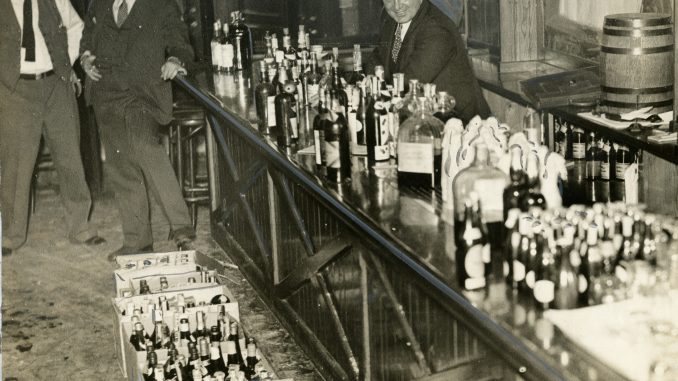
On Nov. 7, 1920, below the fold of the Philadelphia Inquirer one headline read “Hearse kept moving; no one dead, but five barrels liquor found.”
Whiskey was being covertly transported by hearse from a South Philadelphia undertaker to a popular saloon at 16th and Wharton streets. The agents seized more than $40,000 worth of illicit booze.
This technique was just one way Philadelphia saloon owners were increasingly crafty in order to avoid the city’s prohibition enforcement agents, or “dry agents” as they were known at the time, according to the Bureau of Alcohol, Tobacco, Firearms and Explosives.
Prohibition, or the 18th Amendment, took effect in 1920 and lasted until 1933. The amendment prohibited the manufacture, transport or sale of alcoholic liquors, but did not prohibit drinking the beverages, according to ATF. This led to the creation of “speakeasies,” or private, unlicensed barrooms, according to the Mob Museum, a Prohibition and 19th-century museum in Las Vegas.
“It’s funny because 100 years after Prohibition there has been a resurgence of the speakeasy-style bar in Philadelphia,” said Amy Cohen, director of Education at History Making Productions, which produces documentaries, including one covering Prohibition-era Philadelphia. “When something is secret or illicit, it often adds to the fun. The 100th anniversary is timely, but I think there is also an appeal of the illicit when imbibing.”
The Prohibition movement emerged after years of lobbying, primarily from women’s temperance groups. This political mobilization around Prohibition helped women gain a platform in national politics. Soon after, the 19th Amendment, which gave women the right to vote, was ratified, Cohen said.
During Prohibition, Philadelphia was known to be “wet as the Atlantic Ocean,” since it saw little local law enforcement, said Annie Anderson, manager of research and public programming at Eastern State Penitentiary.
“By in large, police officers and officials looked the other way and were in some instances…receiving bribes from local saloons and bootleggers,” Anderson said. “So it was actually profitable for police officers to turn a blind eye to this illegal activity. I don’t think Prohibition invented corruption in Philadelphia, but it definitely exacerbated it.”
Prohibition’s dismal enforcement in Philadelphia is reflected by a relatively low number of saloon closures. When the amendment took effect, Philadelphia was home to about 1,700 saloons. A decade later, still under Prohibition, officials estimated there were still around 1,200 saloons operating relatively freely, Anderson said.
An integral character in Philadelphia’s dry era was Lt. Smedley Darlington Butler, a decorated military officer who became the city’s director of public safety in 1924, she added.
Butler, nicknamed the “Fighting Quaker,” with a strong penchant for law and order, posed the largest threat to the city’s bootleggers and organized crime bosses, the New York Times reported. He took a more intensive approach to alcohol enforcement compared to past city officials, Anderson said.
“There is a huge increase in arrests when Smedley Butler takes the reigns from his predecessor,” she added.
Yet, most people who were caught breaking Prohibition laws did not go to prison or jail but rather were fined. As a result, violators saw few concrete repercussions and most saloon and speakeasy proprietors saw fines from the city as more or less the cost of doing business, Anderson said.
Butler’s relentless attitude toward curbing crime and corruption in Philadelphia would ultimately cut his tenure short. His abrasive leadership style brought him to odds with the city’s then-mayor, Freeland Kendrick, who relieved Butler of his post in 1926, Cohen said.
“If you banned alcohol today, I’m sure it wouldn’t be much different than how it went the first time,” said Kejsi Shahaj, a 20-year-old who lives on 16th Street near Cecil B. Moore Avenue. “I think Philadelphian’s are going to be drinking regardless.”



Be the first to comment